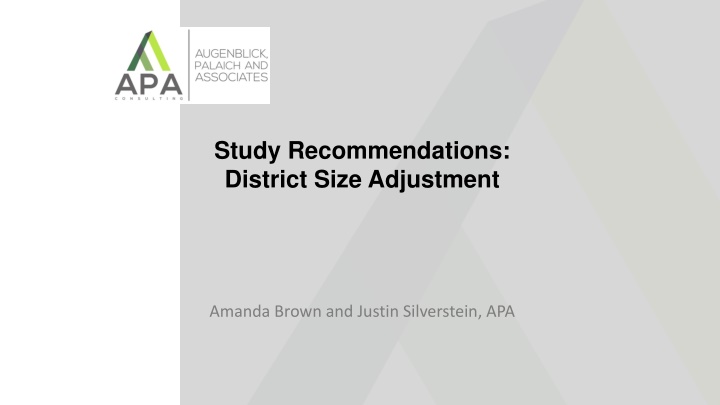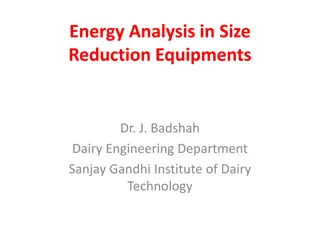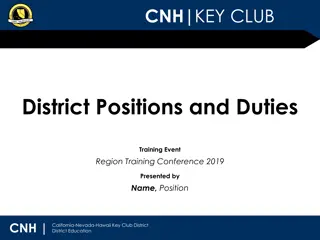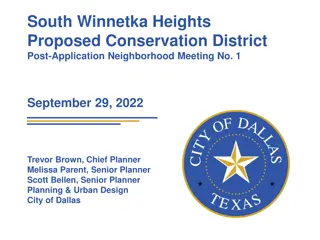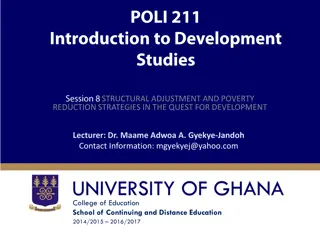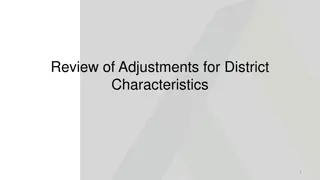Study Recommendations: District Size Adjustment
Overview of recommendations for district size adjustment from a study conducted by Amanda Brown and Justin Silverstein, APA. The study team developed adjustment factors based on research, providing insights into funding formulas and cost considerations for districts of varying sizes.
Download Presentation

Please find below an Image/Link to download the presentation.
The content on the website is provided AS IS for your information and personal use only. It may not be sold, licensed, or shared on other websites without obtaining consent from the author.If you encounter any issues during the download, it is possible that the publisher has removed the file from their server.
You are allowed to download the files provided on this website for personal or commercial use, subject to the condition that they are used lawfully. All files are the property of their respective owners.
The content on the website is provided AS IS for your information and personal use only. It may not be sold, licensed, or shared on other websites without obtaining consent from the author.
E N D
Presentation Transcript
Study Recommendations: District Size Adjustment Amanda Brown and Justin Silverstein, APA
Presentation Overview Review recommended district size adjustment from study Provide additional analysis of recommended size adjustments Committee considerations, including review of future stakeholder feedback areas 2
District Size Adjustment from Study Chart The study team recommended that a new funding formula include a district size adjustment to account for different economies of scale in districts. The study team developed a size adjustment factor based upon: Results of the current study and 2006 adequacy study, combined with school finance research presented in the 2012 AIR report. School finance research depicts the relationship between size and cost as a J-curve: 3
District Size Adjustment from Study The J-curve relationship is consistent with the results of the 2018 evidence- based (EB) and 2015 professional judgement (PJ) studies, that while based on two different district sizes (3,900 for EB, and 50,000 for PJ), but were similar in terms of per-pupil costs. The 2006 study provided smaller size data points- a minimum at 50 students and a smaller data point at 780 students- that also were consistent with the J- curve seen in research. These data points were used to develop the following formula (with the $9,238 base used as the floor of 1.0): For districts above 3,900 students: size adjustment factor = (-.000001735*enrollment) + 1.0868 For districts below 3900 students: size adjustment factor = (-0.281*ln(enrollment)) + 3.4 4
District Size Adjustment from Study Continued This formula was used to develop a size factor to apply to any base amount, shown below at different size points: District Enrollment 50 100 250 500 1,000 2,000 3,000 4,000 7,500 10,000 50,000 300,000 Size Adjustment Factor 2.30 2.11 1.85 1.65 1.46 1.26 1.15 1.08 1.00 1.00 1.00 1.00 The study team recommended the size factor for each district be applied to the base separately from any other adjustments. 5
Additional Analysis on District Size Adjustment To support the Commission in determining if the recommended district size adjustment was the best fit for Nevada, APA was asked to provide additional information and analysis. APA reviewed size adjustment policies nationally Compared the study s recommended size adjustment against: Nevada s current approach (District Groupings/Basic Support Ratios) Current district expenditures Size adjustments in two other states, Colorado and Kansas States with size adjustments and rural/urban variation 6
Size Adjustments in Other States States often address district differences based upon district or school size, and isolation or density. 9 states adjust for district size 7 states adjust for school size 4 states adjust for district density (students per square mile) 14 states adjust for isolated schools (based upon distance from next nearest school, travel time or other travel related issues like road safety conditions) 7
Comparison to Basic Support Ratio (District Groupings Approach) Currently, Nevada accounts for size, density, and cost differences by creating a relative cost factor (Basic Support Ratio) for each district. BSRs are calculated by grouping similar districts together, then comparing districts based upon differences in their prior year s personnel and operational expenditures to create a relative adjustment. Potential issues: Rationale for grouping districts is subjective Based upon expenditures (which are based upon available revenue, historical decision making) Relative to other districts Variable from year to year, not predicable 8
Comparison to Basic Support Ratio (District Groupings) Continued APA recommended unpacking the adjustment approach to separately consider: District size Small and isolated schools (addressed in prior presentation on Necessarily Small School adjustment) Regional cost differences (addressed at next Commission meeting) Creates predictable adjustments that are not based upon prior expenditures or relative to other districts 9
Table Comparison to Basic Support Ratio (District Groupings) FY19 Average Daily Enrollment (ADE) APA Small Schools Adjustment (Imputed) APA APA District Size Adjustment Combined Size Factors Current BSR Groupings Centralized Centralized Centralized Centralized Rural Rural Rural Rural Rural Small Small Small Small Very Small Very Small Large Large FY16, FY17 BSR FY18, FY19 BSR District Carson City Churchill Douglas Lyon Elko Humboldt Lander Nye White Pine Lincoln Mineral Pershing Storey Esmeralda Eureka Clark Washoe FY20 BSR 7,710 3,210 319,033 5,698 9,849 1.20 1.18 1.21 1.21 1.33 1.31 1.39 1.35 1.35 1.86 1.69 1.64 1.80 3.83 3.18 0.96 1.00 1.21 1.22 1.24 1.22 1.38 1.39 1.51 1.40 1.39 1.81 1.69 1.68 1.80 3.47 3.34 0.96 0.98 1.14 1.16 1.17 1.17 1.25 1.28 1.38 1.29 1.44 1.92 1.68 1.64 1.71 3.20 2.69 0.96 0.99 1.07 1.13 1.00 1.08 1.07 2.17 1.80 1.11 1.47 1.49 1.07 1.63 1.08 1.58 1.68 1.00 1.33 0.00 0.00 0.00 0.02 0.02 0.30 0.06 0.08 0.02 0.06 0.00 0.04 0.05 0.07 0.05 0.00 0.07 1.07 1.13 1.00 1.09 1.09 2.46 1.86 1.19 1.49 1.54 1.07 1.67 1.12 1.65 1.73 1.00 1.41 81 295 3,404 972 910 8,817 542 5,266 658 456 63,930 1,558 10
Chart Comparison to Basic Support Ratio (District Groupings) Comparing BSR to APA's Size Adjustments 5.00 4.50 4.00 3.50 FY20 BSR APA Size Adjustments 3.00 Average BSR APA Size Adjustments 2.50 2.00 1.50 1.00 0 1000 2000 3000 4000 5000 6000 7000 8000 9000 10000 11
Comparison to Basic Support Ratio (District Groupings) Shape of data is similar (J-curve). The recommended size adjustments are lower in most districts than FY20 BSRs. Primary differences are for districts with 3,500-10,000 students (including districts in the Centralized Grouping) and around 300 students and below (Very Small grouping). Size adjustment does not include density which may be a factor. Data is based on actual expenditures, so is impacted by local capacity and spending levels. 12
Comparison to Current Expenditures (FY19) APA then compared the recommended size adjustments to current expenditures in districts Expenditures expressed as factor of lowest data point (Clark) Size adjustments are lower for all districts (other than Clark) than current expenditures expressed as factors Expenditures figures are not adjusted for wealth/available outside revenues 13
Table Comparison to Current Expenditures (FY19) FY19 Expenditures, General Fund (Salaries and Benefits + Operational Expenses) Total Student Esmeralda 81 $2,105,445 $26,025 Eureka 295 $8,336,386 $28,297 Storey 456 $5,390,201 $11,821 Mineral 542 $5,999,917 $11,070 Pershing 658 $7,228,430 $10,985 Lincoln 910 $12,931,213 $14,210 Lander 972 $9,759,040 $10,040 White Pine 1,558 $10,915,101 $7,006 Churchill 3,210 $26,778,490 $8,341 Humboldt 3,404 $30,957,529 $9,094 Nye 5,266 $42,798,656 $8,127 Douglas 5,698 $46,104,227 $8,091 Carson City 7,710 $60,257,696 $7,816 Lyon 8,817 $64,170,935 $7,278 Elko 9,849 $87,264,664 $8,860 Washoe 63,930 $420,549,337 $6,578 Clark 319,033 $1,793,195,154 $5,621 FY19 APA Small Schools Adjustment (Imputed) FY19 Average Daily Enrollment Expenditures, General Fund Per APA District Size Adjustment Expenditures as Factor of lowest APA Combined Size Adjustments District 4.63 5.03 2.10 1.97 1.95 2.53 1.79 1.25 1.48 1.62 1.45 1.44 1.39 1.29 1.58 1.17 1.00 2.17 1.80 1.68 1.63 1.58 1.49 1.47 1.33 1.13 1.11 1.08 1.08 1.07 1.07 1.07 1.00 1.00 0.30 0.06 0.05 0.04 0.07 0.06 0.02 0.07 0.00 0.08 0.05 0.02 0.00 0.00 0.02 0.00 0.00 2.46 1.86 1.73 1.67 1.65 1.54 1.49 1.41 1.13 1.19 1.12 1.09 1.07 1.07 1.09 1.00 1.00 14
Chart Comparison to Current Expenditures (FY19) Comparing Current Expenditures to APA's Size Adjustments 5.50 5.00 4.50 4.00 APA Size Adjustments 3.50 Current Expenditures APA Size Adjustments 3.00 Current Expenditures 2.50 2.00 1.50 1.00 0 1000 2000 3000 4000 5000 6000 7000 8000 9000 10000 15
Comparison to Other States Comparing recommended district size adjustment to Colorado and Kansas Colorado: Small districts receive additional funding through the application of a "size factor" to the per-pupil base amount based upon the district s size. Districts under 5,000 pupils have the highest size factor. Districts with over 5,000 pupils receive a size factor that increases their per-pupil funding by about 3%. Kansas: Linear size adjustment formula. Districts with 100 or fewer students receive a weighting of approximately 101.4 percent of the enrollment of the district, and that amount transitions to approximately 3.5 percent of the enrollment of the district as the enrollment approaches 1,622 students. 16
Table Comparison to Other States APA District Size Adjustment District FY19 ADE Colorado Kansas Esmeralda Eureka Storey Mineral Pershing Lincoln Lander White Pine Churchill Humboldt Nye Douglas Carson City Lyon Elko Washoe Clark 81 295 456 542 658 910 972 1,558 3,210 3,404 5,266 5,698 7,710 8,817 9,849 63,930 319,033 2.17 1.80 1.68 1.63 1.58 1.49 1.47 1.33 1.13 1.11 1.08 1.08 1.07 1.07 1.07 1.00 1.00 2.28 1.51 1.24 1.22 1.20 1.15 1.13 1.09 1.04 1.04 1.03 1.03 1.03 1.03 1.03 1.03 1.03 2.03 1.89 1.79 1.73 1.66 1.50 1.46 1.08 1.00 1.00 1.00 1.00 1.00 1.00 1.00 1.00 1.00 17
Chart Comparison to Other States Comparison to Colorado and Kansas 2.40 2.20 2.00 APA District Size Adjustment 1.80 Colorado Kansas APA District Size Adjustment 1.60 Colorado Kansas 1.40 1.20 1.00 0 1,000 2,000 3,000 4,000 5,000 6,000 7,000 8,000 9,000 10,000 18
Comparison to Other States Continued Recommended district size adjustment is higher than the adjustments in either state Exception, Colorado gives a .03 adjustment at minimum 19
Committee Considerations Initial feedback on the additional analysis? Alternative(s) you would like modeled? Creating formula based upon current BSR? This builds in current capacity and expenditure data Other? What stakeholder input would you like to hear? Other questions? 20
Areas for Stakeholder Feedback District Size Adjustment What are the costs that drive differences in resource needs for smaller districts in Nevada? Are these impacted purely by size or is location or density a factor? Is the recommended size adjustment formula the right approach? As an alternative, should a size adjustment be developed based upon BSR? 21
